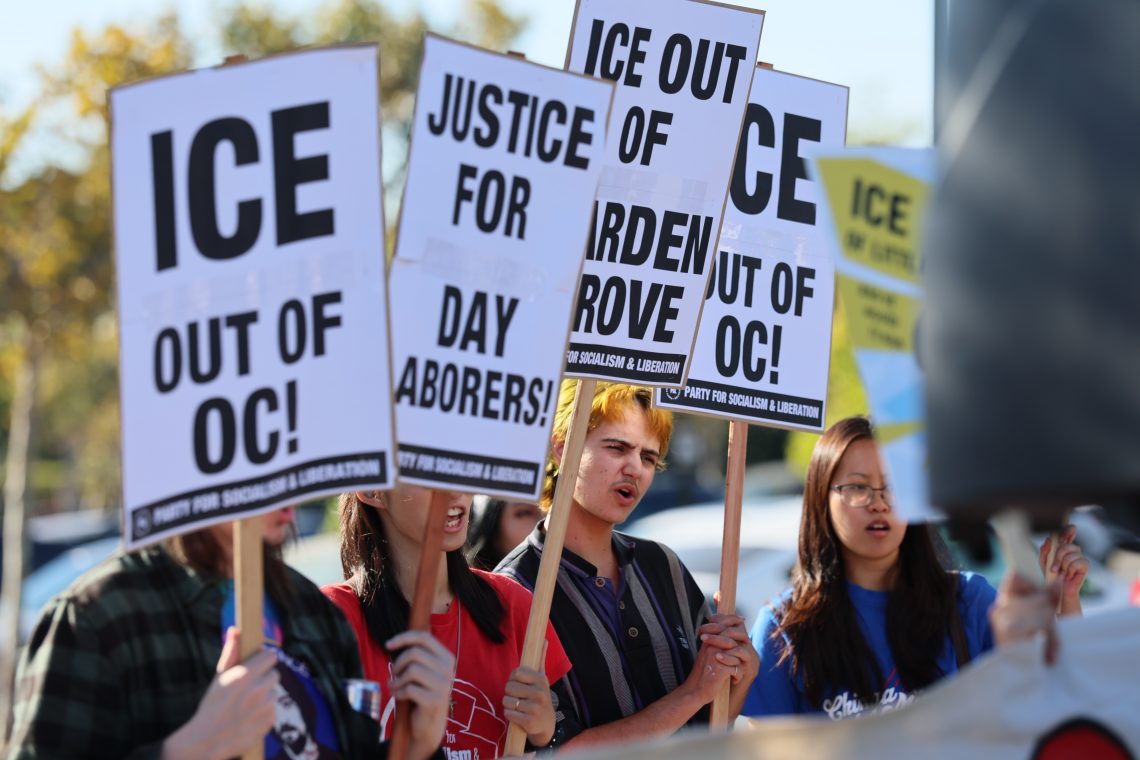Making sense of California’s clash with the Trump administration
Tensions between California and Washington will persist in the short term, but may gradually ease as the U.S. shifts to the right.

In a nutshell
- Political and legal fights reflect a deeper struggle over citizenship and rule
- Data suggests Trump-led reforms in states like California will succeed
- Continued shifts could narrow federal-state divisions
- For comprehensive insights, tune into our AI-powered podcast here
The past several months in the United States may have created the impression of a country drifting toward civil war. Policy impasses between the federal government and states and cities are serving as flashpoints for legal action and protests. In June, raids and arrests conducted by Immigration and Customs Enforcement (ICE) in Los Angeles sparked days of local riots and isolated national protests against federal authorities.
Immigration is a key point of tension between the federal government and local authorities. Federal efforts to deport illegal immigrants have led to confrontations with Democratic-led sanctuary states like California, and cities that refuse to cooperate with federal immigration enforcement. While central, immigration is only one of several issues where courts are being asked to settle fundamental disputes over governance, authority and citizenship.
Rising tensions over core issues
There are echoes of the Civil War in both the images of rioters attacking federal law enforcement, and in the rhetoric between members of the Trump administration and Democratic governors and mayors. Indeed, scholars and pundits have been debating whether or not the U.S. is headed toward a second civil war for several years now. President Donald Trump’s executive order ending birthright citizenship, along with the lawsuits challenging it, conveys the sense that the U.S. is engaged in a 10th-Amendment struggle over states seeking to resist a consolidation of federal power. However, this type of analysis overlooks the deeper paradox underpinning the administration’s policy reforms.
Facts & figures
California governance
California, with nearly 39 million residents, is the most populous U.S. state and has an economy that would rank among the top five globally if it were a country. Sacramento serves as the state capital and the seat of government. Its legislature has been dominated by Democrats for decades, giving the state a stable partisan orientation even as national politics have shifted.
The state exercises considerable autonomy in areas such as environmental regulation, labor law and consumer protection. Its assertive regulatory stance has led to recurring clashes with Washington, particularly under Republican administrations, over issues ranging from vehicle emissions standards to immigration enforcement. California’s judiciary also plays an important role in mediating these disputes, with state courts frequently serving as venues for challenges to federal policies.
On the one hand, the Trump administration is seeking to reinforce sovereignty and citizenship. On the other, it is simultaneously seeking to devolve power back to local authorities and reduce the size of the federal government and eliminate wasteful spending across the country. Both of these dynamics stand in marked contrast to states like California, where state policy has diminished the importance of citizenship while centralizing state power. Taken together, standoffs between the federal government and predominantly Democratic-led states represent a deeper conflict than immigration alone.
California and national policy divergence
Legally and politically, California and Mr. Trump’s federal government are long-time adversaries. While some states already had sanctuary laws to prevent local officials from cooperating with federal authorities, it was California that arguably turned such policies into a national movement. Prior to Mr. Trump’s 2016 election, California led liberal states in implementing measures that conflicted with national immigration law. As far back as 2013, it had passed Assembly Bill 60, which allowed illegal immigrants to secure drivers’ licenses.
During Mr. Trump’s first term, Sacramento passed State Senate Bill 54, also known as the “California Values Act,” to limit the ability of local law enforcement to cooperate with ICE. This was followed by New York’s adoption of a statewide sanctuary policy that same year, with Andrew Cuomo’s Executive Order 170. Massachusetts, Rhode Island and Oregon also deepened their sanctuary policies that year, with New Jersey, Vermont and Washington following suit over the following two years.
Immigration is the exclusive domain of the federal government, which highlights how the divergence of liberal states from national policy represents something deeper than a single-issue policy disagreement; rather, disagreement over state versus federal authority and immigration is the product of a deeper American schism. Political polarization drastically increased between the mid-1990s and 2014, with Democratic and Republican voters respectively becoming competing voting blocs with few centrist views uniting them.
In the following period, beginning with the 2016 election cycle and continuing through the Covid era and administration of President Joe Biden, polarization between the two parties did anything but dissipate. In 2022, the Pew Research Center found that not only is polarization sticky, but that ongoing partisanship has been eroding trust in the two-party system overall. During the Biden years, Pew found that few Americans saw common ground on any main policy issue.

Economically, the growing political homogeneity within states and the partisan clashes with Washington whenever power shifts create problems for legal continuity and predictability. The politics of spite easily translates into contradictory policies that make business across the U.S. difficult. Unabated, this divergence represents a growing and long-term threat to business.
There are tentative signs that this profound polarization may ease, both in California and nationally. Data from Sacramento’s disputes with the federal government suggests how this could happen.
A possible policy convergence to the center
In 2024, President Trump won the popular vote by almost 5 million votes. This bucked historical trends for Republican presidents in general, with George W. Bush in 2004 being the last Republican to win both the electoral and popular votes. It also revealed deeper political shifts that challenge a number of long-held assumptions.
In 2004, a book titled “The Emerging Democratic Majority” by political scientists John B. Judis and Ruy Teixeira outlined how the Democratic Party was then on track to secure a lasting winning coalition due to broad support among minorities and educated urbanites.
This theory was seemingly vindicated by the charismatic rise of Barack Obama in 2008. Challenging conventional wisdom and commentators alike, President Trump’s 2024 inroads with Black and Hispanic men, younger voters and White women led to an electoral success that few mainstream analysts were expecting.
Since the 2024 election, polls suggest the shift stems less from Mr. Trump himself than from changing voter alignments after the pandemic and discontent with Democratic policies on immigration, public safety and the economy.
More by Ian Oxnevad
- India and China compete to shape Africa’s economic future
- U.S. political divide turns tariffs into subnational economic challenge
- IMEC could reshape Europe’s trade dynamics
One recent Wall Street Journal poll found that 63 percent of voters see the Democratic Party as “out of touch,” and its favorability stands at a 30-year low. These findings are corroborated by similar national findings by Emerson, and by the Democratic super-PAC, Unite the Country. Changes in voter registration tell a similar story, with the country as a whole moving to the right.
For sanctuary jurisdictions, such as cities like New York and states like California, which similarly serve as a litmus test for political polarization translating into policy battles, these changes can seem counterintuitive. For example, New York City and Minneapolis both have Democratic-endorsed mayoral candidates that are not only proposing radical policies in housing and public safety, but are also espousing markedly antisemitic rhetoric while taking stances on the Middle East conflict.
As the country as a whole shifts rightward, the Democrats who remain are becoming more radical in their positions. This narrowing of appeal leaves the party weaker than a centrist movement with a conservative label. California still leans reliably Democratic, but even there, broader national political shifts are beginning to take shape.
Since the mid-1990s, analysts of Californian politics have often cited policies under Republican governor Pete Wilson as the reason Hispanic voters shifted to the Democratic Party. Proposition 187, a ballot referendum meant to deny public services to illegal immigrants in the state, is credited as alienating generations of Hispanic California voters from the GOP. The 2024 election challenged the idea that demographics alone predict voting behavior, as many Hispanic Californians shifted toward President Trump in line with national patterns.
Hispanic Republicans in California recently formed their own caucus. The state’s minority voters, long a bedrock of support for the Democratic Party, are increasingly switching to the Republican Party. While it is premature to predict California flipping to the GOP, these moves may signal a shift that will reduce the kind of single-party stranglehold that intensifies polarization and clashes with the federal government.
Most metrics from the mid-1990s demonstrate a long-term shift toward hyper-partisanship across American politics. Flashpoints between states and Washington over immigration, education, transgender athletes and environmental policy show that polarization carries real consequences, depending on which party controls the presidency. Tensions between liberal states like California and the second Trump administration reflect this dynamic, though they are less intense than in 2020 as broader trends show Americans moving rightward across most demographics.
If the GOP continues to expand, its broader coalition will push it toward moderation. Democrats seeking national relevance would face the same incentive. If so, today’s era of intense partisan conflict could ease.
Scenarios
Most likely: Diminishing power of blue jurisdictions and a shift toward policy re-convergence
Battles in the courts and the streets of Los Angeles between federal authorities and local officials lend credence to the idea that the U.S. is on the precipice of a civil war. While these fights grab headlines, deeper polling and shifting coalitions point to potential reconciliation on the horizon.
Political polarization over the past three decades foreshadowed today’s policy battles on elemental issues of governance, such as taxation, the meaning of citizenship and fiscal responsibility. Should the Republican Party continue to diversify and grow, liberal sanctuary cities and states like California will ultimately face existential pressures to moderate or face political irrelevance. This is the most likely scenario.
The changes that currently point to eventual political reconciliation and compromise only became apparent over the past two years, but they are difficult to ignore. Political polarization enables extremism in policy, because it emboldens the policy platforms it produces. Driven by a political theory based on demographics and seemingly vindicated by the electoral successes of the Obama years, the Democratic Party has pursued increasingly progressive policies in areas like citizenship and wealth redistribution. Through their supermajorities in states like California and control of urban centers, the Democrats have sought to confront the federal government over immigration authority and economic policy.
Because demographics that were assumed to be part of the Democratic coalition are shifting to the Republican Party in growing numbers, the ability of the Democrats to continually face off against the federal government may be short-lived. Currently, multiple indicators suggest that this rightward shift among most demographics will increase incentives for political parties to moderate.
Less likely: Movement toward confederation
Over the past several decades, the U.S. has been moving toward de facto confederation. States like California have settled into progressive single-party dominance, just as states like Florida and Texas have become increasingly Republican. Both sides have clashed with Washington, depending on who controls Congress and the presidency, over fundamental policy issues such as citizenship, the border, gender and the role of government itself. This dynamic is not only politically unhealthy for business and economic growth, but it is untenable in the long term.
However, multiple legal and constitutional changes that followed the Civil War solidified federal supremacy over states’ rights. Despite the bravado of multiple states in the current pseudo-civil war that has dominated U.S. politics over the past decade, these safeguards remain.
The prominence of the dollar, and the dependence of Americans upon federal programs like Medicare and Social Security, create financial safeguards that make full secession nearly impossible from an economic vantage point. At the same time, how the law is enforced in light of conflicting state and federal laws can lead to confederation in everything but name.
Confederation would be inherently unstable in the American context, but does represent the culmination of the current status quo if polarization in policy continues without reconciliation.
Contact us today for tailored geopolitical insights and industry-specific advisory services.









